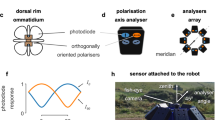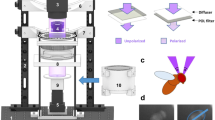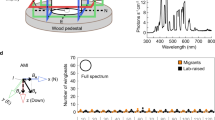Abstract
Some insects and vertebrates use the pattern of polarized light in the sky as an optical compass1,2,3,4,5. Only a small section of clear sky needs to be visible for bees and ants to obtain a compass bearing for accurate navigation5,6. The receptors involved in the polarization compass are confined to a small part of the retina, and the eyes are built predominantly for other visual tasks7. Here we report the discovery of a unique compass organ in the spider Drassodes cupreus, where a pair of specialized secondary eyes cooperate to analyse skylight polarization. These eyes do not form images, but use a built-in polarization filter to determine precisely the direction of polarization. Measurements using a model eye indicate that the compass organ is best suited for navigation at dusk and dawn. Behavioural experiments show that the spiders are primarily active after sunset and that they use polarization cues to find their way back to the nest after foraging trips. A similar organization of the secondary eyes in several spider families indicates that such compass organs may not be an isolated phenomenon.
This is a preview of subscription content, access via your institution
Access options
Subscribe to this journal
Receive 51 print issues and online access
$199.00 per year
only $3.90 per issue
Buy this article
- Purchase on Springer Link
- Instant access to full article PDF
Prices may be subject to local taxes which are calculated during checkout




Similar content being viewed by others
References
Freake,M. J. Evidence for orientation using the e-vector direction of polarized light in the sleepy lizard Tiliqua rugosa. J. Exp. Biol. 202, 1159–1166 (1999).
Waterman,T. H. in Handbook of Sensory Physiology Vol. VII/6B (ed. Autrum, H.) 281–469 (Springer, Berlin, 1981).
Hawryshyn,C. W. Polarization vision in fish. Am. Sci. 80, 164–175 (1992).
Able,K. P. Skylight polarization patterns and the orientation of migratory birds. J. Exp. Biol. 141, 241–256 (1989).
von Frisch,K. Die Polarisation des Himmels licht als orien terender Faktor bei den Tanzen der Bienen. Experientia 5, 142–148 (1949).
Fent,K. Polarized skylight orientation in the desert ant Cataglyphis. J. Comp. Physiol. A 158, 145–150 (1986).
Wehner,R. in Fortschritte der Zoologie vol. 39 (eds Schilderberg, K. & Elsner, N.) 103–143 (1994).
Goldsmith,T. H. & Wehner,R. Restrictions of rotational and translational diffusion of pigment in the membranes of a rhabdomeric photoreceptor. J. Gen. Physiol. 70, 453–490 (1977).
Snyder,A. W. Polarization sensitivity of individual retinula cells. J. Comp. Physiol. 83, 331–360 (1973).
Kirschfeld,K. Vision of polarized light. Int. Biophys. Congr. 4, 289–296 (Moscow, 1973).
Labhart,T. Polarization-opponent interneurons in the insect visual system. Nature 331, 435–437 (1988).
Wehner,R. in Orientation and Communication in Arthropods (ed. Lehrer, M.) 145–185 (Birkhäuser, Basel, 1997).
Görner,P. Die Orientierung der Trichterspinne nach polarisiertem Licht. Z. Verg. Physiol. 45, 307–314 (1962).
Magni,F., Papi,F., Savely,H. E. & Tongiorgi,P. Research on the structure and physiology of the eyes of a lycosid spider. II. The role of different pairs of eyes in astronomical orientation. Arch. Ital. Biol. 102, 123–136 (1964).
Homann,H. Die Nebenaugen der Araneen. Zoo. Jahrb. Anat. 71, 56–144 (1951).
Land,M. F. in Neurobiology of Arachnids (ed. Barth, F. G.) 53–78 (Springer, Berlin, 1985).
Bernard,G. D. & Wehner,R. Functional similarities between polarization vision and color vision. Vision Res. 17, 1019–1028 (1977).
Labhart,T. The electrophysiology of photoreceptors in different eye regions of the desert ant, Cataglyphis bicolor. J. Comp. Physiol. A 158, 1–7 (1986).
Labhart,T. Specialized photoreceptors at the dorsal rim of the honeybee's compound eye: polarizational and angular sensitivity. J. Comp. Physiol. 141, 19–30 (1980).
Brines,M. L. & Gould,J. L. Skylight polarization patterns and animal orientation. J. Exp. Biol. 96, 69–91 (1982).
Blest,A. D. in Neurobiology of Arachnids (ed. Barth, F. G.) 79–102 (Springer, Berlin, 1985).
Nilsson,D.-E. Three unexpected cases of refracting superposition eyes in crustaceans. J. Comp. Physiol. A 167, 71–78 (1990).
Nilsson,D.-E. & Howard,J. Intensity and polarization of the eyeshine in butterflies. J. Comp. Physiol. A 166, 51–56 (1989).
Acknowledgements
We thank P. Willander and L. Jonsson for help in finding and identifying the spiders. Information about Gnaphosoids was provided by N. Platnick. R. Wallén provided technical assistance. Financial support came from the Swedish Natural Science Research Council.
Author information
Authors and Affiliations
Corresponding authors
Supplementary information
Rights and permissions
About this article
Cite this article
Dacke, M., Nilsson, DE., Warrant, E. et al. Built-in polarizers form part of a compass organ in spiders. Nature 401, 470–473 (1999). https://doi.org/10.1038/46773
Received:
Accepted:
Issue Date:
DOI: https://doi.org/10.1038/46773
This article is cited by
-
Comparative biology of spatial navigation in three arachnid orders (Amblypygi, Araneae, and Scorpiones)
Journal of Comparative Physiology A (2023)
-
Visual control of refuge recognition in the whip spider Phrynus marginemaculatus
Journal of Comparative Physiology A (2021)
-
Direct-write orientation of charge-transfer liquid crystals enables polarization-based coding and encryption
Scientific Reports (2020)
-
Homing in the arachnid taxa Araneae and Amblypygi
Animal Cognition (2020)
-
Non-visual homing and the current status of navigation in scorpions
Animal Cognition (2020)
Comments
By submitting a comment you agree to abide by our Terms and Community Guidelines. If you find something abusive or that does not comply with our terms or guidelines please flag it as inappropriate.



